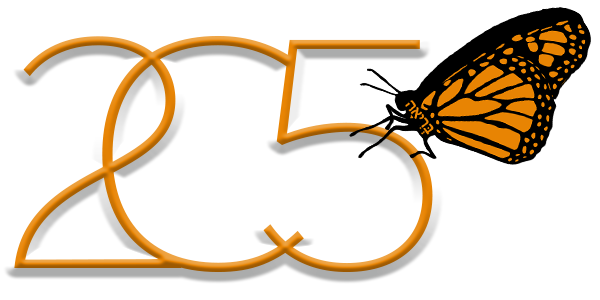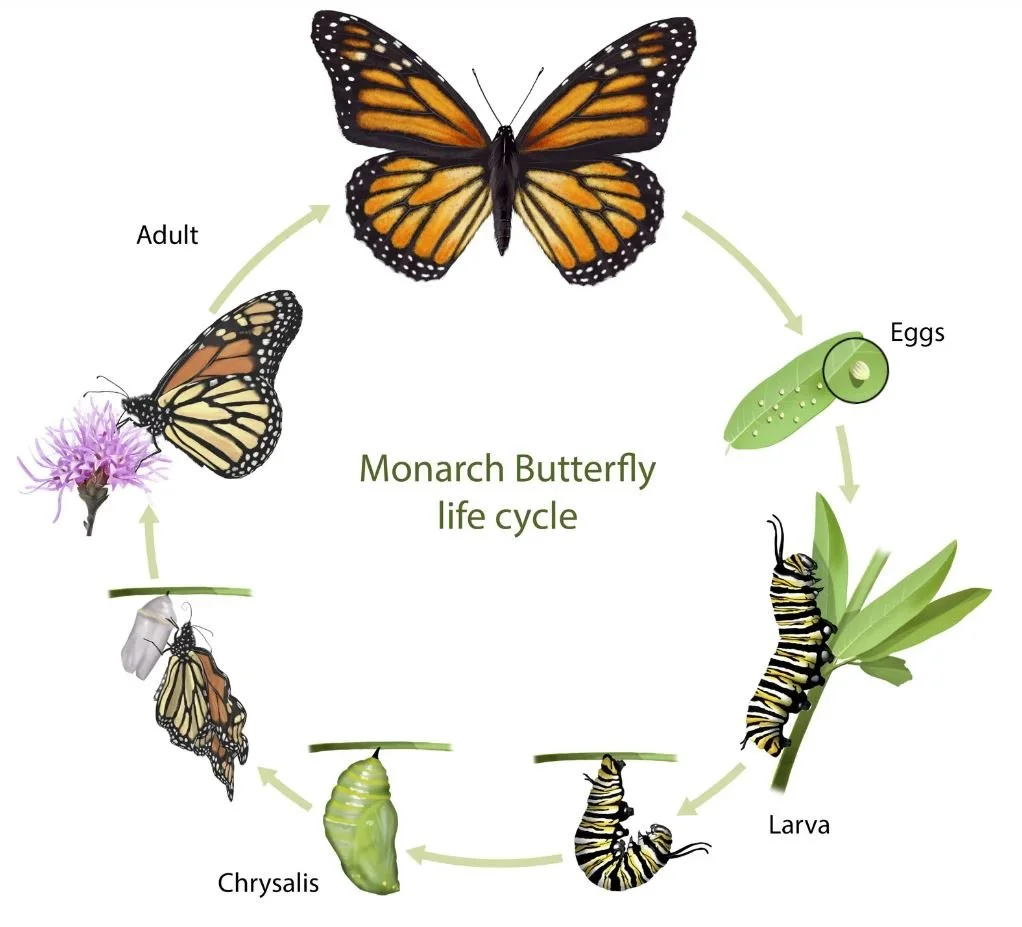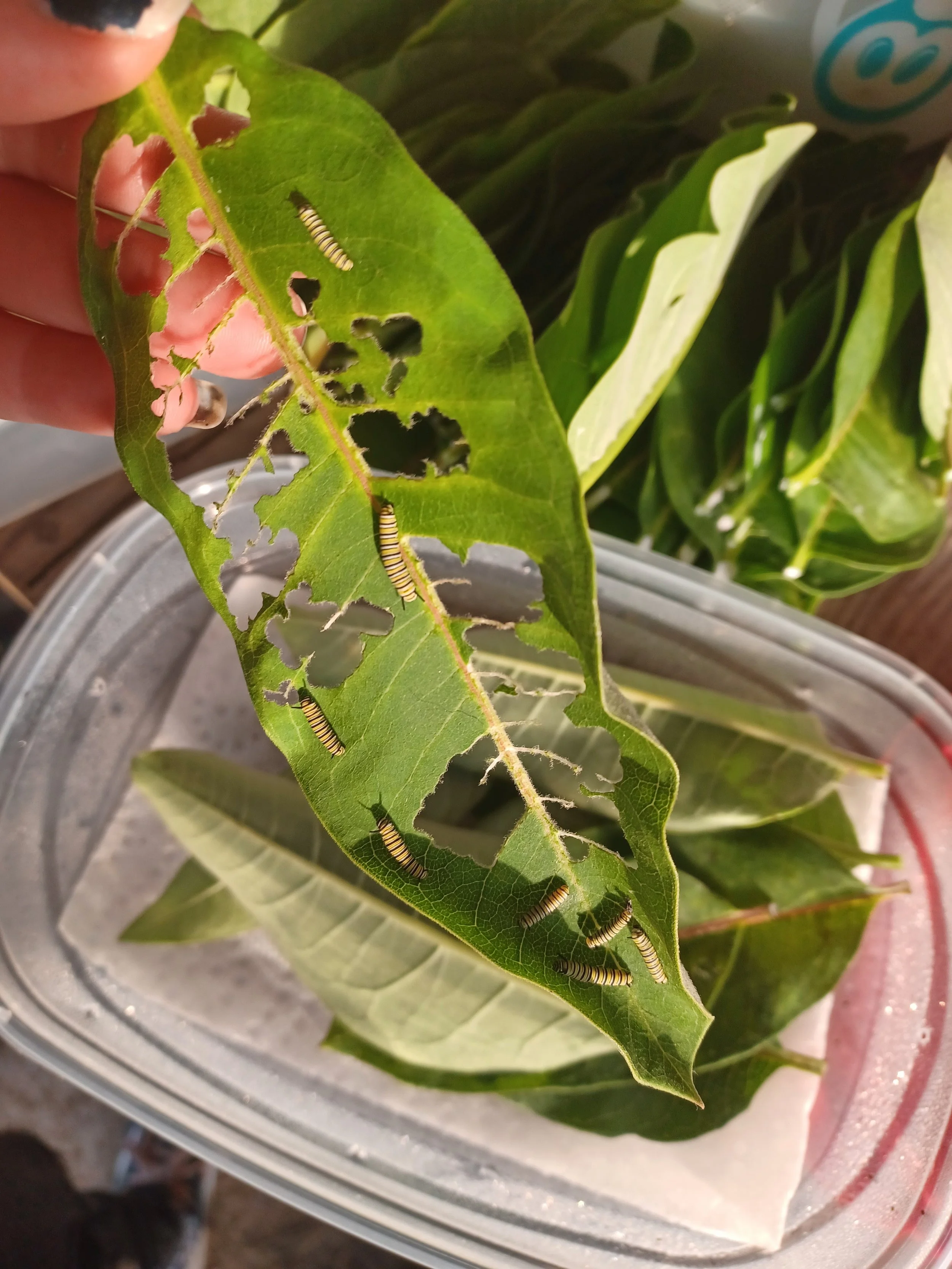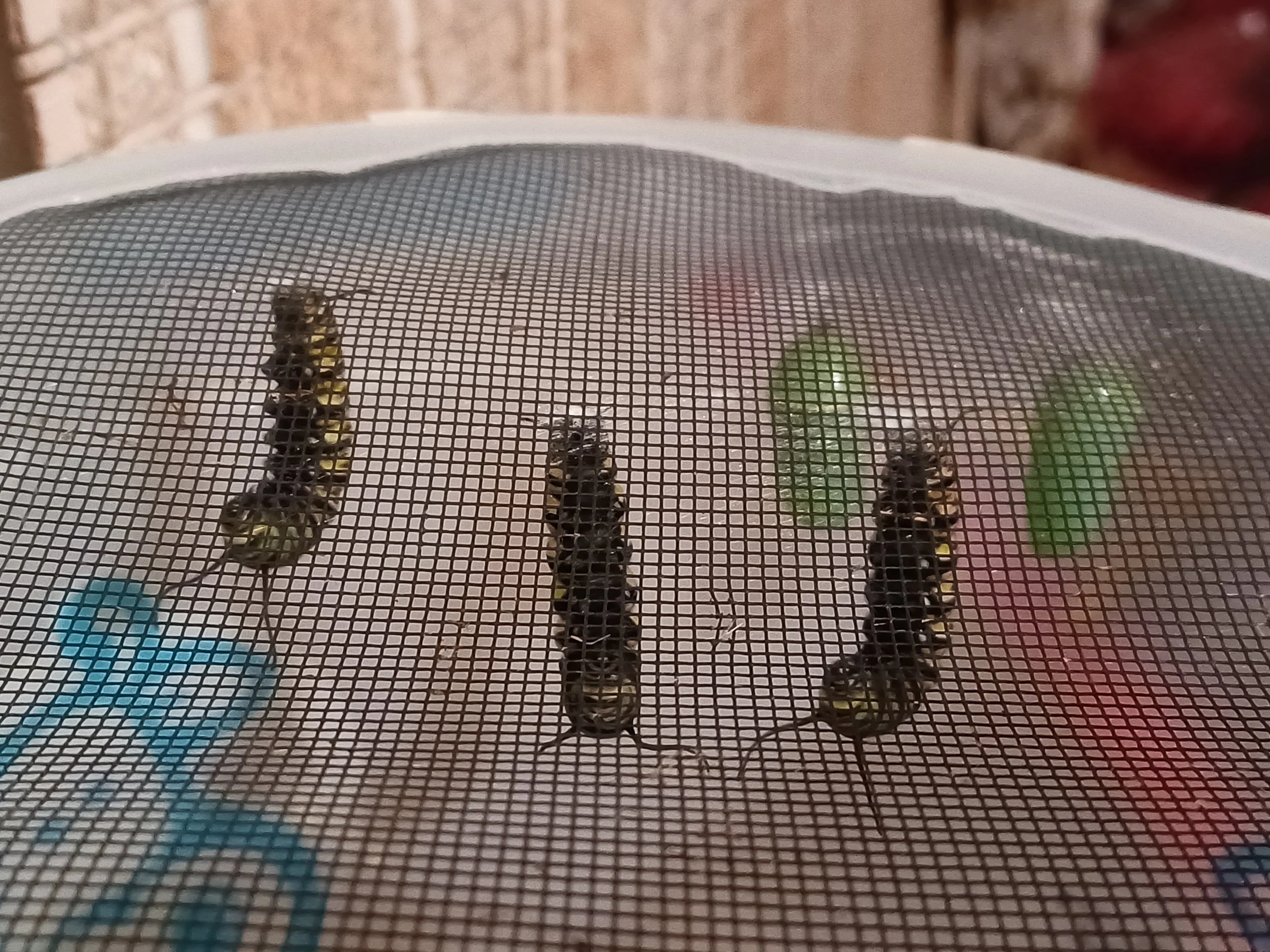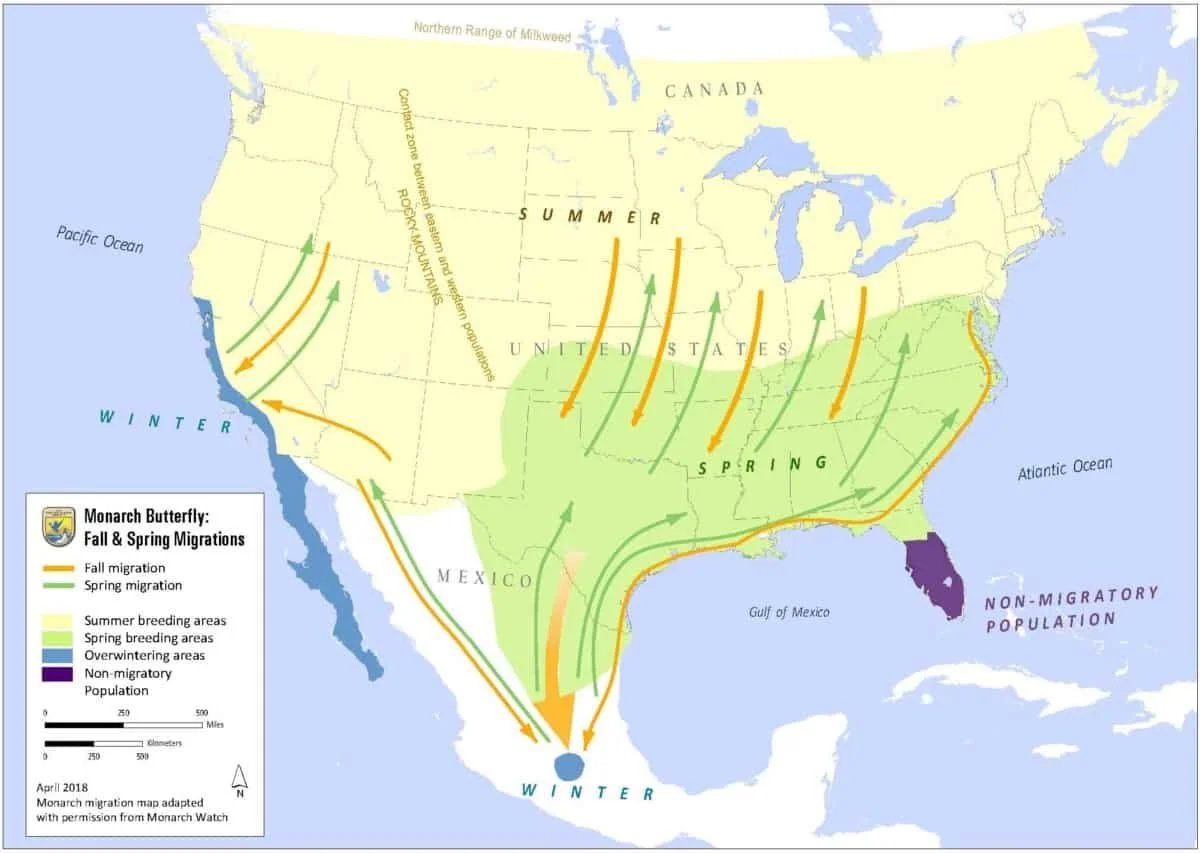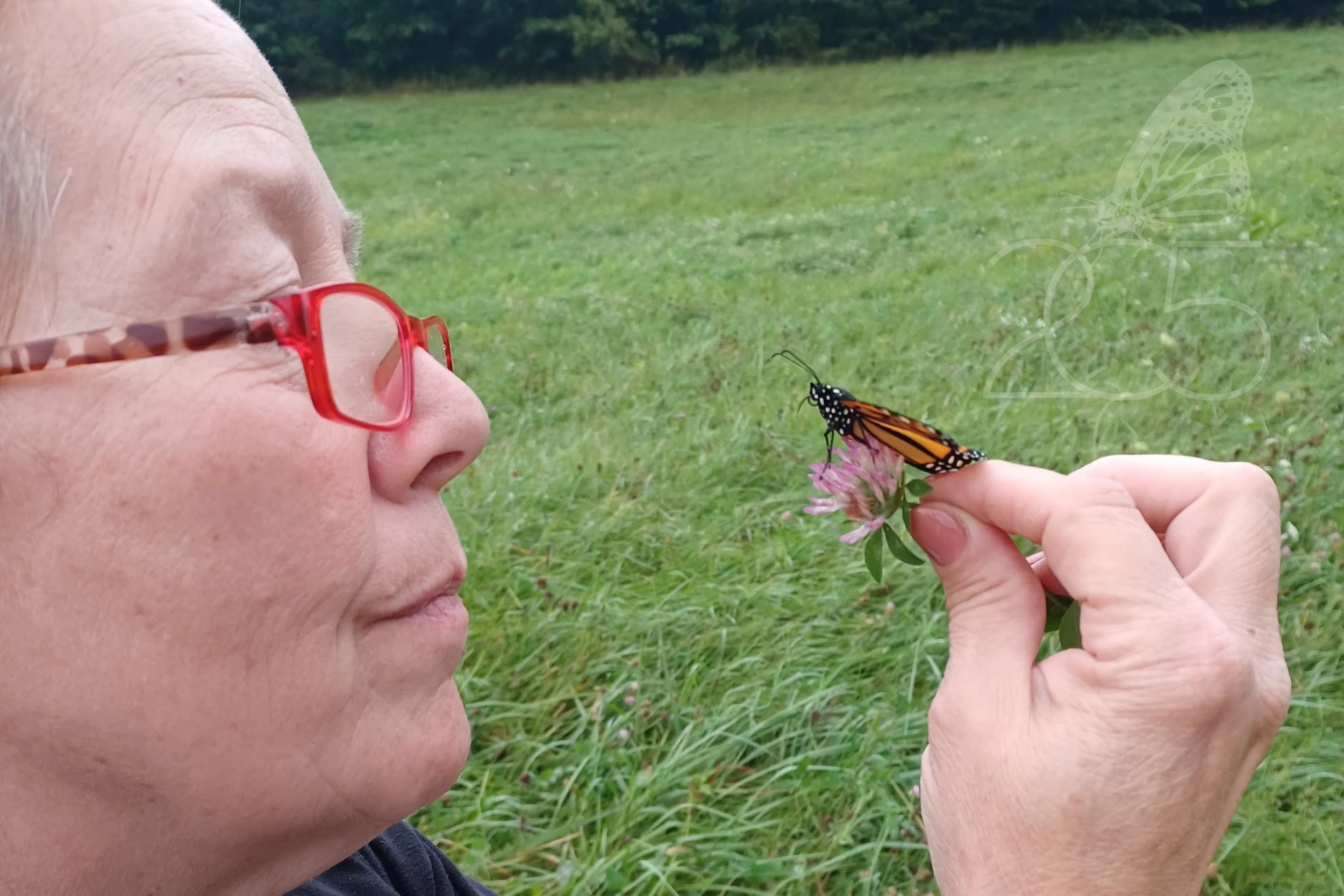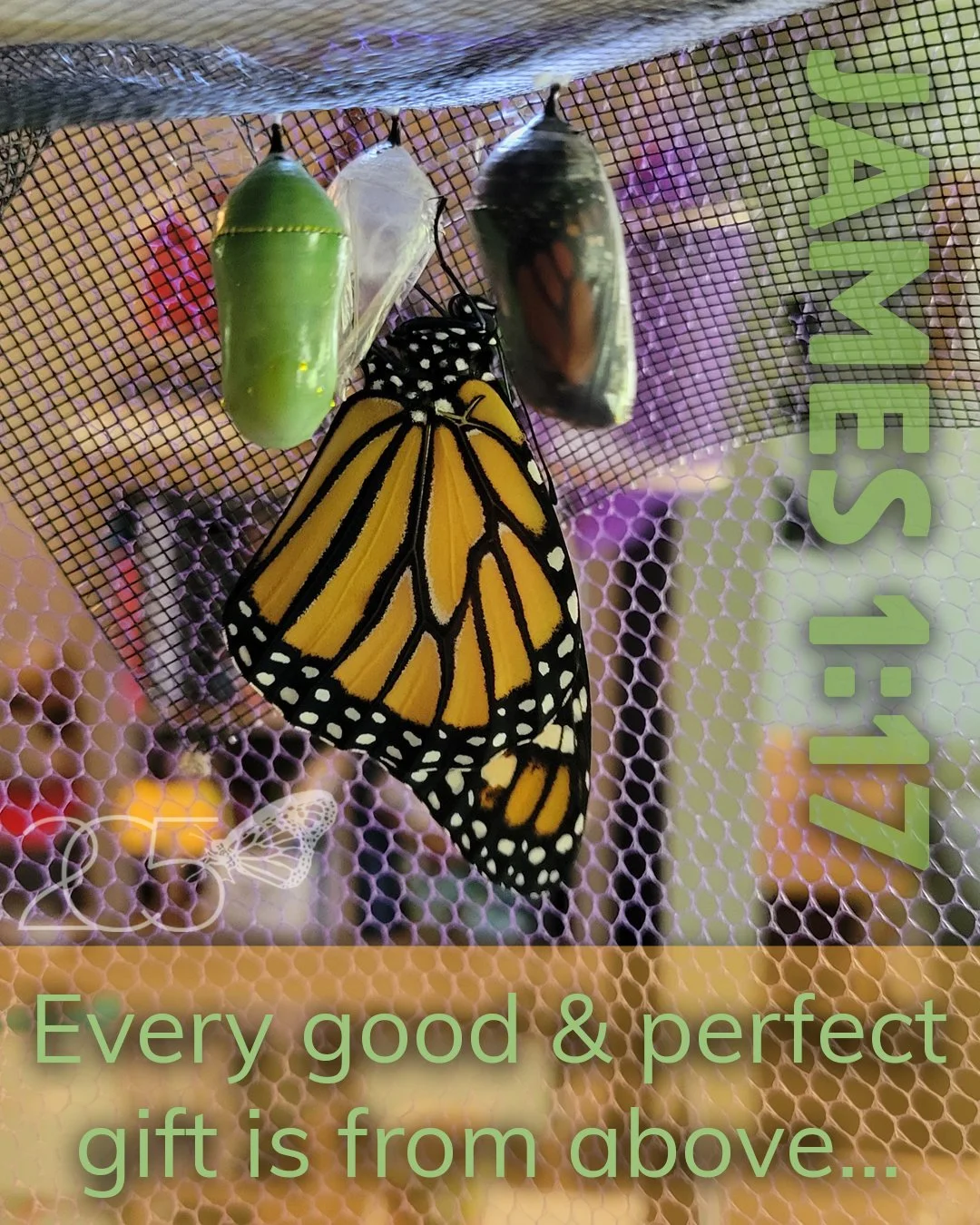For the Love of Monarch Butterflies
When I was in fourth grade, The Mothman gave an assembly at my elementary school. He taught us about moths, butterflies, their life cycles, and so on and so forth… At the end of his presentation, he announced he would be giving the presentation again (at the school) in the evening for anyone who would like to hear it again.
My mom graciously agreed to take me back to school for this and enjoy this presentation for herself.
At this presentation, The Mothman showed us a simple way of creating a butterfly net using embroidery hoops and craft mesh. My mom made dish washing scrubbies (from mesh), and she was crafty, so she had embroidery hoops too… it was destiny!
20 some (or more) years later…
A friend of mine, Kendra, showed my kids and me her flower gardens. They aren't just any gardens. They have all of the right mixes of the right plant species to make these beautiful gardens certified sanctuaries - ready for helping birds and….. butterflies! Not just that, but Kendra has perfected the loving chore of helping protect butterflies until they reach the state of butterflydom (and yes, I just made that word up).
A quick science lesson…
Butterflies begin life like many other living creatures - as an egg. Caterpillars (or larva) are hatched from the egg and eat and eat and eat until their little bodies are ready to begin transformation. In order to transform, caterpillars go into a chrysalis (or pupa).
Fun fact: Chrysalises and Cocoons are NOT the same thing. Butterflies go into chrysalis (which is more like a protective shell or exoskeleton that is exposed as they molt) and moths go into a cocoon (which is a protective shell that is constructed around a moth caterpillar that is either made of their own silk or sometimes plant matter that they gather around themselves).
Different kinds of butterflies spend different amounts of times in chrysalis - transforming.
For both moth and butterfly, after their tiny bodies complete their miraculous transformations, in their chrysalises and their cocoons, they emerge from their “shells” (if you will) as a whole new creation!
Of course!
A couple years ago, Kendra was taking a vacation, and she kindly asked my kids and me if we wouldn’t mind taking care of her caterpillars and chrysalises while she was away. Of course we wouldn’t mind! This short week or so gave us a great opportunity to test these new waters…
The following year, she encouraged and coached us when we discovered monarch butterflies were laying eggs around our house. It was amazing. And terrifying. And beautiful. And a lot!
Learning to protect Monarchs
Let’s start from the beginning of the life cycle.
Monarch butterflies are brilliant. Mommy monarchs somehow KNOW to only lay their eggs on milkweed plants. This is the PERFECT plant for prepping a monarch caterpillar for chrysalis and butterflydom (yep - I used that fake word again).
Eggs are typically (not always, but usually) found on the bottom side of milkweed leaves.
Eggs are about the size of the point of a ball-point pen.
If you look closely, the eggs have fine lines that actually make the egg oblong, and right before they hatch, the top of the egg reveals the caterpillars sweet, little, black head.
Eggs hatch about three to four days after they are laid. (Note: Not all eggs laid are fertilized.)
When they hatch, they are itty bitty!
The next couple weeks is the time when they are most susceptible to prey.
For the next 10-14 days of these sweet little babies’ lives, they need all of the protection they can get. They need to eat (and subsequently - poop) a lot (emphasis on the LOT) while they grow to become mature larva that are ready to head into chrysalis.
Caterpillars molt various times during their first two weeks - shedding their exoskeleton like a snake.
We have found that monarch caterpillars (in captivity anyway) love to stay together… It is so sweet!
They even stay together as they prepare to go into chrysalis.
After their first two weeksish of eating (and pooping) and molting, and eating (and pooping) and molting, eating (and pooping) and molting, they are ready to head into their next stage of life.
First, they create a silk (from their butts) to hang upside down in a J formation…
While they hang, what is happening under their exterior is actually pretty gross… They are liquefying. Ew! Their final caterpillar exoskeleton is actually all a facade that they shed when it is time.
You will know it is time for chrysalis when the J drops to a straight hanging formation and their antennas become lifeless.
Another fun fact: Butterflies have long, skinny antennas that usually have a small ball or thin-point at the end. Moths have feathery antennas. Both use their antenna as a tool for their senses.
Next, they begin doing crazy crunches with their full “belly” squishing their bodies up and down until their exoskeleton is squeezed the whole way to the top.
Once they get that old, skin to the top (where their butt is attached with the silk), they swing themselves in a circle, around the old skin, using the exoskeleton to create a stronger and more secure attachment to where they attached their silk. This will help better their chances for making it into their next stage.
The final molt to chrysalis stage happens very fast. If it starts and you walk away for two minutes, you could very well miss the whole event.
But, after they are in… they are in. The chrysalises quickly take on the beautiful green visual with gold specks that monarchs are known for.
Then….. we wait…..
After another 10-14 days (colder temperatures make it take longer than warmer temps), the chrysalis becomes completely transparent, and a miracle occurs.
Inside that beautiful chrysalis the long, stubby-legged creature (truth be told, only six of those dozen or so stubs are actual legs - the rest are suctions that help the caterpillar cling and climb) has lost their stubs and now have long, stick-like legs, fuzzy bodies, and big beautiful wings that hang off its back.
metamorphosis (noun) meta·mor·pho·sis (plural, metamorphoses): a typically marked and more or less abrupt developmental change in the form or structure of an animal occurring subsequent to birth or hatching
example: the metamorphosis of caterpillars into butterflies
- Miriam Webster Dictionary
At first, their abdomen is filled with fluid that they must lose to be able to take flight. Their wings also need time to unfurl and expand.
Another new feature the butterflies have when they first emerge is their new tongue.
They no longer nibble and crunch on leaves. Now, they have two long straws that they use to drink nectar - their NEW food source. When they first emerge from their chrysalis, the monarch uses its front two legs/feet (that you don’t usually see, making it seem like they only have four legs) to help fuse the two “straws” together. It is important for this step - if the fusing doesn’t happen, their tongue will not be strong enough to roll/unroll for eating.
After a few hours of fusing, drying, dripping, and learning how to flap its new wings, the new butterfly is ready for flight.
If the weather is warm (not below 65 degrees) and fair (not raining or too windy as to not rip their new, fragile wings) the butterfly will tell you he/she is ready to go with their excitement and wing activity.
The best time to release monarch butterflies is an hour or so before sunset. This increases their chance of survival since they will need to follow the sun to begin their journey to Mexico.
This was our very first monarch release - Alpha.
If monarch butterflies sense bad weather coming, they will not take flight. They will wait until the conditions are right. If you have bad weather for more than a day, making it impossible to release a butterfly, you can provide nectar-rich flowers for them to drink from or soak a paper towel in sugar water or hummingbird food (don’t make it too wet as to not drown them) and place it at the bottom of their net.
Monarchs are the only butterfly species in North America who migrate. Monarchs that leave Pennsylvania to migrate south to Mexico (having been born after mid August) can live up to nine months!
We feel like such proud parents each time we see one take flight.
What have we gotten ourselves into?
When the time is right, and the monarchs have started visiting, my mom and I check the wild milkweed around our homes (my mom lives next door - making these convenient) for monarch eggs and caterpillars.
We line the bottom of plastic containers with damp paper towels (I find that the brand Plenty is perfect), poke holes for fresh air, and provide fresh milkweek leaves (make sure they are not moldy or gross).
Each morning, we check on the food levels and spray/refresh their paper towels. In the afternoon/evening, we clean out all of their poop (did I mention they poop a lot?), provide fresh, damp paper towels (where needed), and replenish their leaves. As they get bigger, they will need fed at least twice a day.
We have perfected the moisture needed in each container (each stage needing different conditions), the poop cleaning, and the feeding for these little leaf monsters. (They eat a LOT!) …It is extremely important that they have fresh and healthy leaves to eat.
In 2023, we helped 56 monarchs achieve butterflydom (ok - last time). We named each one before it took flight.
Things got out of hand in 2024…. The monarchs must have spread the word that we were great hosts because we could gather fresh leaves without coming back from the plants with more and more and more and more eggs and caterpillars. We had to increase capacity, buy dozens of pop-up hampers to use as nets, and get creative with “baby” storage.
We use plastic leftover containers for the eggs and wee-little caterpillars. When they get bigger, they are upgraded to ice cream buckets that are covered with old (but clean) window screens. They go into chrysalis on these screens. We then move the screens to the tops of butterfly nets (like the ones I made as taught by The Mothman) or (as we have now added to our collection) by pinning the screens to the top of a skinny, mesh, top-opening hamper.
By the end of the 2024 monarch season, we had helped 238 monarch butterflies, and yes - we named each one (not a one getting a name already used).
Not every caterpillar is a success story…
Some caterpillars consume or fall prey to parasites. This can prevent them from making it to chrysalis. Other times, it can prevent them from successful metamorphosis. Instead, they might do all of the work to get into a chrysalis, but while in chrysalis, they become discolored and will never emerge a butterfly. :(
Monarch Gender Identification
Once they are butterflies, there is a way to tell if a monarch is a male or female.
The males have an extra dot (or spot) towards the bottom of their wings. Females’ wings only have straight, clean lines.
Linda
In 2023, we learned first-hand about the importance of the tongue fusing when we met Linda.
There was a group of four caterpillars that ate, grew, went into chrysalis, and emerged from chrysalis together. When it was time to take flight, three flew, but one would not. The other three waited around for a long time before giving up (I guess their instincts kicked into gear) and they took off towards the sunset. The one left behind was Linda.
I looked closely at her and noticed that she looked like she had a snake’s tongue. It was split. Her “straws” never fused. We freaked out. We researched it, and I called Kendra. She gave us the same report as the articles we read: If the tongue didn’t fuse together in the first hours after emerging, Linda’s chances of survival were not good.
We should have noticed earlier. If we had, we could have used a toothpick to help stretch her tongue out and encourage it to do its job. But, we didn’t. However, we also didn’t give up.
Over the next few days, we helped provide easy to eat food for Linda: hummingbird nectar and watermelon juice. We used a toothpick to help unroll her tongue in order for her to be able to suck up the juice. We soaked a Q-tip with juices and helped her unroll the straws for her to be able to eat from the Q-tip.
Linda trusted us. She would just hang out on our shirts (like a brooch) or our shoulders (like a parrot).
After that few days, we noticed that she no longer had a snake tongue. It took a while, but she got it fused! We took Linda out to the flowers that the other butterflies were loving and she was rolling/unrolling her straws and eating just like she should! We were so proud of her! However, now she loved us too much and wouldn’t take flight.
We took Linda outside and encouraged her to fly three or more times a day for a couple days before she found her confidence… and then, she left. #proudparents
Why milkweed?
Milkweed’s scientific name is Asclepias. It is a herbaceous, perennial, flowering plant named for its latex. The latex is a milky (and very sticky if you get it on your hands) substance that contains cardiac glycosides (or cardenolides). This milky stuff comes out when the milkweed leaves are broken off, the plant is trimmed, or the plant/leaves are damaged in some way. Monarchs have not only become accustom to the taste of the milkweed plant, they rely on its toxins (from the cardiac glycosides) to help make them poisonous to some predators. Some milkweed is more toxic than others. No matter the toxicity level, monarchs bright orange and contrasting black warn predators, “I have been eating toxins my whole life, so don’t even think about it!”
This defense is so effective, other butterflies have adapted to copy the patterns of the monarch - trying to make their predators think that they too are poisonous. Some of these copy cats include: the queen butterfly, viceroy, and soldier butterfly.
So, the point of what Kendra, and my mom and I do is helping get monarchs to the point of being able to warn-off their predators. It is a chore of love, but also totally rewarding.
Those Beautiful Wings… Don’t Touch!!!
It is not a great idea to touch a butterfly’s wings (unless totally necessary).
The powder (which is actually tiny scales) covering their wings helps them fly and communicate and is a form of protection. Touching a butterfly’s wings can rub the powder off and potentially affect the butterfly’s ability to fly. While this will not immediately kill it, it could shorten its lifespan and harm its overall well-being. So, if you have to handle a butterfly, let them walk on you with their own legs and, if you have to, only grab its body… not wings.
Other ways to help the Monarchs
The U.S. Fish & Wildlife Service has reported the monarch butterfly population in North America has declined by up to 72% over the past 10 years. This hurts our ecosystem and environment because monarchs are important pollinators.
According to the U.S. Fish & Wildlife Service, “improving, restoring, and creating habitat and food sources for monarchs can help the species’ numbers.” So, if you are looking to plant, consider planting flowers rich in pollen (like goldenrod, butterfly bush, lilac, zinnia, and of course - milkweed). This will help bring the monarch butterfly (and other kinds of butterflies) population back up. Let’s face it, butterflies are miracles, and we need to do our part to help save them and protect their beauty.
The monarch is proof…
Monarchs are beautiful mysteries.
What is up with the golden dots on their chrysalis? The gold doesn’t have any pigment. One guess is that there are hormones in them that is needed during metamorphosis to form them, but nothing at this point has been proven. The specks do help camouflage and exchange oxygen.
In 2024, there was a night of hours and hours and hours of constant lightning. The next morning, more than 30 caterpillars had gone into J. It was crazy. Yes. This means we had a day of 30 emerging butterflies!
Scientists have a difficult time identifying exactly how or why monarchs migrate the way they do in North America.
It is unfathomable to look at the miracle of the monarch butterfly and deny that God is real. There is no way this extremely intricate species, its perfect life-cycle, and the just-right migration cycle happened or came about by chance.
We have a creative and brilliant Creator who gave us many beautiful gifts… the Monarch is one of them.
